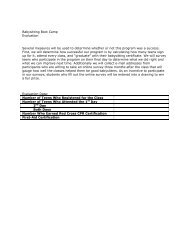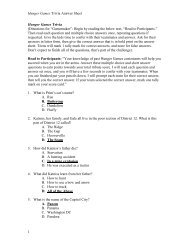Causes of Eutrophication and its Effects of on Aquatic Ecosystems
Causes of Eutrophication and its Effects of on Aquatic Ecosystems
Causes of Eutrophication and its Effects of on Aquatic Ecosystems
Create successful ePaper yourself
Turn your PDF publications into a flip-book with our unique Google optimized e-Paper software.
Figure 4: Comparative bar graph <str<strong>on</strong>g>of</str<strong>on</strong>g> average nutrientt c<strong>on</strong>centrati<strong>on</strong>s (mg/L) <str<strong>on</strong>g>of</str<strong>on</strong>g> waterwithin tanks with <str<strong>on</strong>g>and</str<strong>on</strong>g> without potential fertilizer inputs.Figure 4 illustrates a comparis<strong>on</strong> between the average c<strong>on</strong>centrati<strong>on</strong>s <str<strong>on</strong>g>of</str<strong>on</strong>g> phosphate,amm<strong>on</strong>ium, nitrate, <str<strong>on</strong>g>and</str<strong>on</strong>g> nitrite measured in mg/L found in both the experimentalfertilized tanks<str<strong>on</strong>g>and</str<strong>on</strong>g> the c<strong>on</strong>trol tanks. Though these values are not statistically significant when individualcompounds are compared with a t-test, the bar graph <str<strong>on</strong>g>of</str<strong>on</strong>g> figure 4 shows the differences betweenthe average values <str<strong>on</strong>g>of</str<strong>on</strong>g>the four compounds when compared to <strong>on</strong>e another. As shown, nitrate hasthe highest c<strong>on</strong>centrati<strong>on</strong> <str<strong>on</strong>g>of</str<strong>on</strong>g> any <str<strong>on</strong>g>of</str<strong>on</strong>g> the other nutrients, especially when measuredin tanks withfertilizer input, reaching a peak average c<strong>on</strong>centrati<strong>on</strong> <str<strong>on</strong>g>of</str<strong>on</strong>g>f 4.17 mg/L while <strong>on</strong>ly reaching 1.67mg/L in our c<strong>on</strong>trol tanks. The sec<strong>on</strong>d most comm<strong>on</strong> compound found in the water samples isphosphate, which is relatively c<strong>on</strong>stant between our fertilized <str<strong>on</strong>g>and</str<strong>on</strong>g> c<strong>on</strong>trol groups, showing <strong>on</strong>ly a0.02 mg/ /L differencee between the higher 0.82 mg/L <str<strong>on</strong>g>of</str<strong>on</strong>g> fertilized tanks <str<strong>on</strong>g>and</str<strong>on</strong>g> the 0. .80 mg/L <str<strong>on</strong>g>of</str<strong>on</strong>g> n<strong>on</strong>-anfertilizedtanks. Amm<strong>on</strong>ium is the third highest compound measuredin our tankwater, havingaverage c<strong>on</strong>centrati<strong>on</strong> <str<strong>on</strong>g>of</str<strong>on</strong>g> .2 mg/Lfor fertilized tanks <str<strong>on</strong>g>and</str<strong>on</strong>g>d a .1 mg/L for tanks not experiencing6






